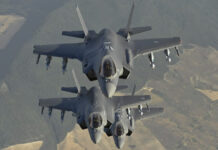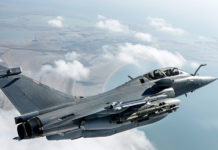Eurocopter’s Tiger HAP – combat support helicopter operated by the French Army was one of the stars at the airshow. The new Spanish Tiger was displayed on the EADS static park. Two missiles were recently added to the Tiger’s growing arsenal – the Israeli Spike ER, selected by the Spanish Army and the Hellfire, opted by the French. 40 HAD Tigers are expected to be equipped with Hellfires by 2012. The French will receive the anti-tank missile (AGM-114K) and blast fragmentation versions (AGM-114M) of the Hellfire. France is also interested in the metal augmented (termobaric) version, but no details about its inclusion in the deal were mentioned.
The Tiger is recently undergoing through a ‘navalization’ qualification preparing it for operation from French Navy ships. The helicopter operated from two French Navy vessels – the Amphibious Landing Dock (ALD) Siroco and Lafayette-type frigate Guépratte. The qualification process is scheduled to complete by 2008, clearing the Tiger for operations from command ships, aircraft carriers and ALDs. The program will include assessments of various aspects, including rotor blade folding, engine rinsing, hydraulic pressure system modifications, and tooling necessary for shipboard operation. The program is closely watched by Australia and Spain which are also interested in such navalized operations.
Nearby, two of the latest the NH90 helicopter were displayed – a German NH9O Tactical Transport Helicopter (TTH), one of four helicopters recently delivered to the German Army, and the first Swedish NH9O in its High Cabin Version (HCV). This helicopter was handed over to the Swedish Air Force during the airshow. Also at Le Bourget, Germany exercised an option to buy additional 42 additional NH90 TTHs. 30 are destined for the Army Air Corps, the other twelve are for the Air Force. Belgium became the 14 country to order the new helicopter, signing an order for 10 new NH90, including four TTH versions, four in NFH (NATO Frigate Helicopter) versions Belgium has options for two additional NH90s. These new announcements brought the program’s order book to 495. Another possible addition to the NH90 is the HELLAS system developed by EADS. HELLAS assists helicopter pilots to avoid obstacles and improve flight safety. The system has already been fielded with German police aviation and the Thai air force. Following successful evaluation by the U.S. Army’s Foreign Comparative Testing program, EADS and US based DRS Technologies, Inc. have established a cooperation to market the system in the USA.
Eurocopter is also conducting an assessment of potential Life Extension Program for the RAF Puma Mk1 helicopters fleet. The planned upgrades will extend the helicopter’s operational life through around 2022. The upgrade for up to 35 Pumas Mk1 (to be designated Puma HC Mk2) could include the new Turbomeca ‘Makila’ engines, a ‘glass’ cockpits, and new communications, navigation and defensive systems. Their performance and payload capability will be significantly enhanced, particularly in hot and high climate conditions. The Pumas are providing the backbone of the RAF’s fleet of medium lift helicopters, and continue to play a vital role in operational theatres such as Iraq, delivering high operational readiness levels.
The Russian company Polyot introduced the Mi-19, an airborne command post based on a derivative of the Mi-17 Hip helicopter. The Mi-19 is operating with tank and motorized infantry regiments of the Russian Army. The Mi-19 is based on the Mi-8MT/Mi-17 platform and is equipped with communications, command and control systems to support continuity and stability of tactical control during combat operations. The Mi-19R is specially configured to provide a regimental command post for supporting rocket artillery. The system supports target acquisition and target generation, coordination and control, by communicating with tactical combat, and combat support elements, aircraft, helicopters and dismounted units.
RAFAEL added a dramatic new capability to attack helicopters – the ability to launch mini-UAVs while airborne. The company demonstrated this capability on their attack helicopter simulator (Helicoat). “The Skylite (mini UAV) was originally developed as a canister launched mini-UAV, so its modification into a helicopter-borne system does not require drastic redesign”, Menachem Dvir from RAFAEL told Defense Update. The canister-launched Skylite was displayed loaded on a quad Spike launcher, identical to a launcher already cleared for helicopters, such as the Spanish Tiger. “When on a mission, helicopters can deploy the Skylite to scan an area without exposing themselves to anti-aircraft threats. When targets are detected, Skylite will hand over the images to the crew, for prosecution with precision guided weapons, such as Spike ER. Attack helicopters are already using UAVs flown by other units to facilitate accelerated ‘kill chains’. Therefore, offering such capability as an integral capability would pose the next logical step” said Dvir.
A modified and modernized version of the Target Acquisition Designation Sight/Pilot Night Vision Sensor (TADS/PNVS), originally developed for the AH-64D Apache helicopter, is now being offered as “Pathfinder” for installation on cargo and utility helicopters, improving operations under night, bad weather as well as ‘brownout’ conditions, the thick dust cloud raised by the rotor as the helicopter hovers low above the ground, during landing and takeoff. Pathfinder is based on the PNVS element of the AH-64D system, offering pilots increased situational awareness and reduced workload.
New Vision Systems Wash ‘Brownout’ Away
The system is based on a thermal imager designed specifically to support takeoff and landing in unprepared areas and low-level, contour and nap-of-the-earth flight profile. The system offers a wide field of view (52 deg.) and rapid refresh rate, supporting both head down (multifunction display) and head-up (helmet display) modes. The system maximizes the pilot’s unobstructed visibility, allowing for earlier identification of obstacles at lower altitudes and higher airspeeds. Continuous display of critical flight data also allows safer flight under extreme conditions. A typical helmet display that could work with the Pathfinder is the TopOwl developed by Thales, selected by Lockheed Martin to demonstrate the modernized PNVS. TopOwl displays high resolution, high accuracy FLIR images and video on a mini-screen positioned near the pilot’s eyes. Thales is currently delivering 350 systems to fulfill initial orders from 15 countries. The company is expecting production capacities of more than 1,500 systems and more over the coming years.
Another safety system for helicopters funded by DARPA, is the ‘Sandblaster’ program. The system will integrate synthetic vision from multiple sensors to improve the pilot vision trough ‘brownout conditions’. Also integrated is a radar-based sensor information with terrain-and obstacle data providing highly detailed three-dimensional view of the landing area on a primary flight display, regardless of outside visibility conditions. The system will provide enhanced ground proximity warning assisting safe landing and takeoff procedures. The synthetic screen, overlaid with symbology indicating current and predicted flight conditions will help pilots land the aircraft without using outside visual reference points. Honeywell expects systems configured for the Black Hawk helicopter cockpit will be ready for delivery by 2010.



















